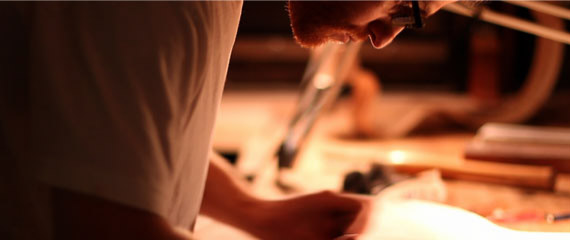About
I started taking guitar lessons at age seven and from that point the guitar became a lifelong passion.
My father, an architect, and my mother, an artist, were the creative influences that helped sow the seeds that would lead to my future. In an effort to learn more about the instrument, I went to the public library and was amazed and inspired by a shelf full of books on the construction of the guitar. At age 14, I asked my parents if I could turn a basement closet into a small workshop. That was where, with the help of my father, I made my first guitar.
At age 14, I asked my parents if I could turn a basement closet into a small workshop. That was where, with the help of my father, I made my first guitar.
After studying guitar performance with Fred Hand for a couple years, I decided to come home to Chicago and enroll in Product Design at Columbia College. With the support of my professors and the college itself, I focused all my work upon the guitar. At this point in my life I had completed six instruments, the last three being archtop guitars.
While making my seventh guitar I met violin maker Michael Darnton and joined the restoration team at Darnton & Hersh Fine Violins. This was the beginning of what was to become a three-year period in which I was introduced to the world of string instruments, the true ancestors of the archtop guitar. While working with Michael I learned and practiced restoration techniques on many museum-quality instruments. To examine, close up, the detail, the knife work, and the overall tradition of some of the most important instrument makers of all time, is paramount in developing your eye. At D&H, I also had the chance to read through and study a library of books written about violin makers and their works. It was also my job to categorize and document every instrument that came through our shop. This was a very repetitive job but it enabled me to see the nuances of different makers and the techniques of their schools.
Michael's work solely encompasses hand tools and traditions based upon methods from the seventeenth century and this is the foundation of my practice. These techniques allow him to create, control, and manipulate each individual rendering of this three hundred year old image of perfect design. Surprisingly, hand work at it's best often occurs at speeds that would trump any machine. I have acquired a lot of power tools over the years and after studying with Michael I have found it almost faster to do things by hand. Michael continues to give me constructive advice and I am forever grateful for his willingness to teach me his passion.


Stay Connected